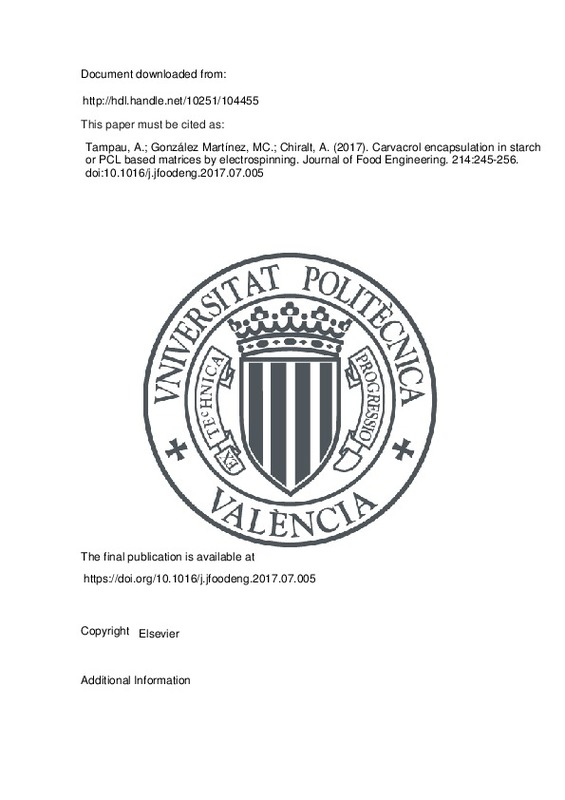JavaScript is disabled for your browser. Some features of this site may not work without it.
Buscar en RiuNet
Listar
Mi cuenta
Estadísticas
Ayuda RiuNet
Admin. UPV
Carvacrol encapsulation in starch or PCL based matrices by electrospinning
Mostrar el registro sencillo del ítem
Ficheros en el ítem
| dc.contributor.author | Tampau, Alina
|
es_ES |
| dc.contributor.author | González Martínez, María Consuelo
|
es_ES |
| dc.contributor.author | Chiralt, A.
|
es_ES |
| dc.date.accessioned | 2018-06-21T04:25:47Z | |
| dc.date.available | 2018-06-21T04:25:47Z | |
| dc.date.issued | 2017 | es_ES |
| dc.identifier.issn | 0260-8774 | es_ES |
| dc.identifier.uri | http://hdl.handle.net/10251/104455 | |
| dc.description.abstract | [EN] Carvacrol (CA) was encapsulated in polar (corn starch-Sodium caseinate, CS:NaCas) or non-polar (poly-¿-caprolactone, PCL) matrices by electrospinning (ES). Electrospunable formulations were prepared with CS:NaCas (9:1 w/w ratio), at 2, 4 and 6 wt % in water, or PCL at 5, 10 and 15 wt% in glacial acetic acid using different CA ratios (0, 5, 10 and 15 wt% with respect to the polymer). The liquid formulations were characterized for electrical conductivity, rheological behaviour and surface tension, and ES process conditions were established. The electrospun structures were analysed as to their nanostructure and CA retention. Geometry of the nanostructures obtained from the PCL systems was nanofibrillar with some beads, whereas it is particles that are mainly deposited for starch systems. PCL systems yielded better CA encapsulation efficiency (EE) than the polar ones, where greater variability was observed. The best EE (around 80%) was obtained for 15% PCL regardless of the CA ratio. | es_ES |
| dc.description.sponsorship | The authors would like to thank the Ministerio de Economia y Competitividad of Spain, for funding this study as part of projects AGL2013-42989-R and AGL2016-76699-R and predoctoral research grant # BES-2014-068100. | |
| dc.language | Inglés | es_ES |
| dc.publisher | Elsevier | es_ES |
| dc.relation.ispartof | Journal of Food Engineering | es_ES |
| dc.rights | Reconocimiento - No comercial - Sin obra derivada (by-nc-nd) | es_ES |
| dc.subject | Electrospinning | es_ES |
| dc.subject | Nanostructure | es_ES |
| dc.subject | Active compound | es_ES |
| dc.subject | Encapsulation efficiency. | es_ES |
| dc.subject.classification | TECNOLOGIA DE ALIMENTOS | es_ES |
| dc.title | Carvacrol encapsulation in starch or PCL based matrices by electrospinning | es_ES |
| dc.type | Artículo | es_ES |
| dc.identifier.doi | 10.1016/j.jfoodeng.2017.07.005 | es_ES |
| dc.relation.projectID | info:eu-repo/grantAgreement/MINECO//BES-2014-068100/ES/BES-2014-068100/ | es_ES |
| dc.relation.projectID | info:eu-repo/grantAgreement/MINECO//AGL2013-42989-R/ES/NUEVOS MATERIALES BIODEGRADABLES MULTICAPA PARA ENVASADO ACTIVO DE ALIMENTOS SENSIBLES AL DETERIORO MICROBIANO Y%2FO OXIDATIVO/ | es_ES |
| dc.relation.projectID | info:eu-repo/grantAgreement/MINECO//AGL2016-76699-R/ES/Materiales Biodegradables Multicapa de Alta Barrera para el Envasado Activo de Alimentos/ | es_ES |
| dc.rights.accessRights | Abierto | es_ES |
| dc.date.embargoEndDate | 2018-12-01 | es_ES |
| dc.contributor.affiliation | Universitat Politècnica de València. Departamento de Tecnología de Alimentos - Departament de Tecnologia d'Aliments | es_ES |
| dc.contributor.affiliation | Universitat Politècnica de València. Instituto Universitario de Ingeniería de Alimentos para el Desarrollo - Institut Universitari d'Enginyeria d'Aliments per al Desenvolupament | es_ES |
| dc.description.bibliographicCitation | Tampau, A.; González Martínez, MC.; Chiralt, A. (2017). Carvacrol encapsulation in starch or PCL based matrices by electrospinning. Journal of Food Engineering. 214:245-256. https://doi.org/10.1016/j.jfoodeng.2017.07.005 | es_ES |
| dc.description.accrualMethod | S | es_ES |
| dc.relation.publisherversion | https://doi.org/10.1016/j.jfoodeng.2017.07.005 | es_ES |
| dc.description.upvformatpinicio | 245 | es_ES |
| dc.description.upvformatpfin | 256 | es_ES |
| dc.type.version | info:eu-repo/semantics/publishedVersion | es_ES |
| dc.description.volume | 214 | es_ES |
| dc.relation.pasarela | S\343415 | es_ES |
| dc.contributor.funder | Ministerio de Economía y Competitividad | es_ES |







![[Cerrado]](/themes/UPV/images/candado.png)

